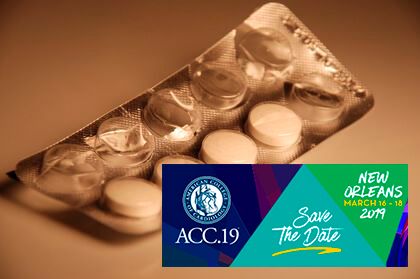This work (presented during the same American College of Cardiology [ACC] 2019 Scientific Session as the STOPDAPT-2 trial) enrolled 2993 patients who underwent angioplasty with current-generation stents Xience, Promus, Synergy, or Orsiro at 33 Korean sites. Patients were randomized to 12 months of dual antiplatelet therapy or dropping aspirin at 3 months.
 There was no difference between the short- and long-term dual antiplatelet therapy regime regarding the primary combined endpoint (death, infarction, stroke), with rates of 2.9% vs 2.5%. This information was confirmed in an exploratory analysis at 90 days.
There was no difference between the short- and long-term dual antiplatelet therapy regime regarding the primary combined endpoint (death, infarction, stroke), with rates of 2.9% vs 2.5%. This information was confirmed in an exploratory analysis at 90 days.
Clinical events at 1 year were similar between study groups, with the exception of higher rates of BARC 2-5 bleeding observed in the group receiving aspirin for 12 months (2.0% vs 3.4%; hazard ratio [HR]: 0.36; 95% confidence interval [CI]: 0.36-0.92; p = 0.02).
All prespecified subgroups seemed to consistently derive benefit, although patients who received prasugrel or ticagrelor (as opposed to clopidogrel) tended to do better.
Read also: ACC 2019 | TAVR in Bicuspids is Safe and Feasible in Real World Patients.
This work suggests that P2Y12 inhibitor monotherapy after short conventional dual antiplatelet therapy is a new strategy that seems to balance well ischemic and bleeding risks in patients undergoing angioplasty.
One of the limitations of this study was that 16% of patients randomized to dropping aspirin at 3 months actually continued taking it.
Read also: ACC 2019 | PARTNER 3: Low Risk TAVR vs. Surgery, Fewer Events per Year.
An important detail is that about half the study population (and the STOPDAPT-2 population) underwent a simple angioplasty; in consequence, these results cannot be generalized.
Original title: P2Y12 Inhibitor Monotherapy Versus Dual Antiplatelet Therapy in Patients Undergoing Percutaneous Coronary Intervention: The SMART-CHOICE Randomized, Open-Label, Noninferiority Trial.
Presenter: Hahn J-Y.
Get the latest scientific articles on interventional cardiologySubscribe to our weekly newsletter
We are interested in your opinion. Please, leave your comments, thoughts, questions, etc., below. They will be most welcome.





